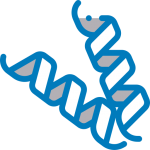
 Cynomolgus / Rhesus macaque FOLR1 Protein, His tag
Cynomolgus / Rhesus macaque FOLR1 Protein, His tag
FO1-C52H8
1mg
Brand
ACROBiosystems
Description
Source :
Cynomolgus / Rhesus macaque FOLR1, His Tag (FO1-C52H8) is expressed from human 293 cells (HEK293). It contains AA Arg 25 – Met 233 (Accession # NP_001181576.1). In the region Arg 25 – Met 233, the AA sequence of Cynomolgus and Rhesus macaque FOLR1 are homologus.
Molecule : FOLR1
Synonyms : FOLR-1,FBP,FOLR
Format : Powder
Category : Bio-Markers & CD Antigens
Accession : NP_001181576.1
Storage : -20℃
Shipping condition : Powder,RT
Molecular Weight : 26.4 kDa
Characteristics :
This protein carries a polyhistidine tag at the C-terminus. The protein has a calculated MW of 26.4 kDa. The protein migrates as 35-41 kDa under reducing (R) condition (SDS-PAGE) due to glycosylation.
Endotoxin Level : Less than 1.0 EU per μg by the LAL method.
Buffer : PBS, pH7.4
Description :
Folate Receptor 1 (FOLR1) is also known as Folate receptor alpha, Folate Binding Protein (FBP), FOLR, and is a member of the folate receptor (FOLR) family. Members of this gene family have a high affinity for folic acid and for several reduced folic acid derivatives, and mediate delivery of 5-methyltetrahydrofolate to the interior of cells. Mature FOLR1 is an N-glycosylated protein that is anchored to the cell surface by a GPI linkage. FOLR1 is predominantly expressed on epithelial cells and is dramatically upregulated on many carcinomas. FOLR1 is internalized to the endosomal system where it dissociates from its ligand before recycling to the cell surface. A soluble form of FOLR1 can be proteolytically shed from the cell surface into the serum and breast milk. Defects in FOLR1 are the cause of neurodegeneration due to cerebral folate transport deficiency (NCFTD). NCFTD is an autosomal recessive disorder resulting from brain-specific folate deficiency early in life.
References :
(1) Lacey SW, et al., 1989, J. Clin. Invest. 84 (2): 715–20.
(2) Elwood PC, 1989, J. Biol. Chem. 264 (25): 14893–901.
(3) Rijnboutt, S. et al., 1996, J. Cell Biol. 132:35.
(4) Parker, N. et al., 2005, Anal. Biochem. 338:284.
(5) Paulos C M, et al., 2004, Mol Pharmacol. 2004;66:1406–1414.
(6) Elwood, P.C. et al., 1991, J. Biol. Chem. 26:2346.
(7) Dainty,L.A. et al., 2007, Gynecol Oncol. 105 (3):563-70.
Application
Reactivity



